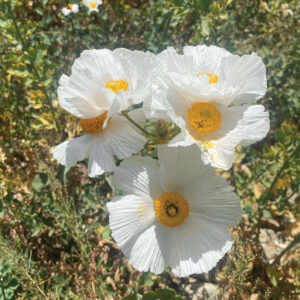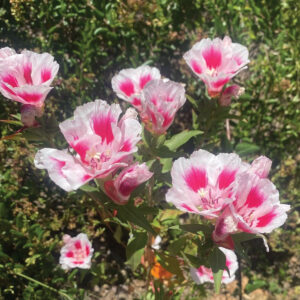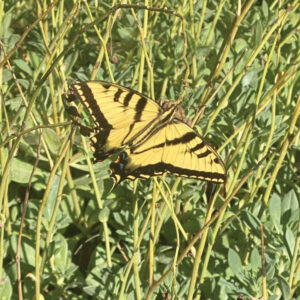
Today I had the pleasure of attending Tomatomania at one of my favorite nurseries, Otto & Sons in Fillmore, California. The day started out with Yoga, so I was in an excellent frame of mind. The vibe of the day was made better by the beautiful drive to Fillmore.
Once I was there I spent some time picking through the hundreds of choices of tomatoes. I bought some for me, some for clients, and some for friends. Some new varieties that I will be trying this year are Violet Jaspey Ortziu (guess why I picked that one?) and Cuore De Toro (Bull’s Heart). The Bull’s Heart is an oxheart tomato, which is bigger than a salad, but smaller than a Beefsteak and very meaty. Can’t wait to see how they turn out. Along with the new, I had to have two of my favorites Brandywine and Sungold.
While I was at Tomatomania, I was lucky enough to listen to Scott Daigre (founder of Tomatomania and owner of the fabulous but no longer in business Hortus Nursery) give a little talk about tomatoes. Here is some information that everyone could use to grow better tomatoes.
Tomatoes need 6 – 8 hours of sun; they don’t need 14 hours of hot sun to bake their roots. Keeping this in mind, you might find a whole new area of your yard that will be good for growing tomatoes. I know that I will. I think that I have been baking my tomatoes! I bet that this year I will have a bumper crop.
Amend, amend, amend! If you want fabulous tomatoes make sure that you add a lot of organic matter into your soil. Most of Cali has either clay (and alkaline) soil or decomposed granite (sandy) and both of them should be amended with plenty of organic matter.
Dig deep, plant deep – if you have a tall tomato seedling, the further you bury it in the ground the more of it can root and give you a great base for your plants.
Fertilizing – Use an organic, balanced fertilizer at planting, fertilize again five wks later (at bloom) and then again five weeks later for beefsteak varieties – or any variety that take a long time to mature. Foliar feeding is good for your tomato plants, once in a while during their development (second and/or third time) especially for container plants. The foliar feeding also allows you to rinse off your tomato leaves. In our heat and dirt, your maters will be happy.
Water- Every time you water you should soak the plant, not the soil around it. Try one cup when it is a seedling, and increase the amount of water as it grows. Don’t increase the frequency of water… just the amount. Let your plant dry out before watering again. In the ground try watering every 2-5 days. The best way to water is deeply & infrequently.
As fruit sets your plant begins not to look as good as it did when it was actively growing in size and producing leaves, it starts to yellows a little. Don’t worry this is natural and don’t think that this is the time to water it more… it’s NOT! You can easily over water at this point. Don’t add extra because it looks yellow! You will dilute the flavor of the tomato and could do worse.
Support:
Support tomatoes! There are many types of tomato support, pick the one that you like and use it. You will be very unhappy at harvest time if you don’t support your tomatoes from the start.
Pinching – It’s a personal decision. If you pinch the little shoots that look like a sucker you get a single leader, which is easier to support on the spirals and you will get less but bigger tomatoes. If you don’t pinch you need to use a more cage like support but you will get more tomatoes (which won’t be as big as if you pinched).
Growing in Containers -Size matters! Bigger is better. Don’t plant a tomato in an 8” pot and expect it to bear fruit. Buy pots that don’t retain heat. If you already have black pots, cover them (in burlap or an old sheet) to keep roots cool. Use a mixture of potting soil & planting mix. Not straight potting soil, it doesn’t have enough nutrients. Water for the plant not the pot. Fertilize every 10 days. You will have to water more frequently, so check your soil and water when the plants need it. Tomatoes develop 10-14 days earlier if planted in a pot. Planting in a pot is great on the coast because it add heat & therefore flexibility in where you can plant your tomatoes. The smaller fruited variety plants do better in pots.
A Few Tips:
When see lots of flowers shake the stakes & pollen will fly, pollinating the flowers. You will have more fruit set.
Pick the fruit when it’s ripe. Not by color. Pick when they are a little soft. Play with your food! Touch them to see if they are ripe. Let them stay on the vines as long as you can, especially cherry tomatoes. A tomato tastes best two days before it’s ready for the compost pile.
To prevent pests be sure to rotate crops or replace soil on containers. And by rotating crops I mean rotate crops by family and tomatoes are in the same family as peppers and eggplants so they have the same pests.
For more information: www.thegrassisalwaysgreener.net
Basket of tomatoes above is from my client & friend, Bernice Hall.











